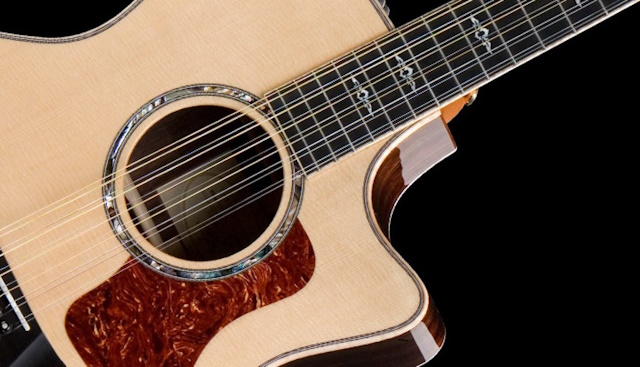[et_pb_section fb_built=”1″ theme_builder_area=”post_content” _builder_version=”4.24.2″ _module_preset=”default”][et_pb_row _builder_version=”4.24.2″ _module_preset=”default” theme_builder_area=”post_content”][et_pb_column _builder_version=”4.24.2″ _module_preset=”default” type=”4_4″ theme_builder_area=”post_content”][et_pb_text _builder_version=”4.24.2″ _module_preset=”default” theme_builder_area=”post_content” hover_enabled=”0″ sticky_enabled=”0″]
The vast majority of guitarists play a six string guitar in standard E tuning. It’s a fairly basic, straight forward affair that most master quickly.
But a number of brave souls venture into the realm of the 12-string guitar, which opens up a whole new can of worms.
The advantage of a 12-string guitar is that it produces a fuller sound than a six string and opens up a wider spectrum of tone.
The down side is that they can be more difficult to play when forming chords due to the wider neck and extra strings.
Also, because there is double the number of strings, changing strings and tuning up is more of a challenge.
Let’s clear up some of the mystery behind the 12-string by looking at how they are tuned.
The strings on a 12-string can be looked at in “pairs”. Each pair of strings is tuned to a note that corresponds with the six notes that a standard six string is tuned to. Here is what the pairs of strings look like:
1st pair – E E
2nd pair – B B
3rd pair – G G
4th pair – D D
5th pair – A A
6th pair – E E
As you can see, the tuning of the “pairs” is identical to the tuning of the individual string notes on a six string guitar.
Within each pair of strings on a 12-string guitar are two strings that are either in “unison”, or an “octave” of each other.
1st Pair – These two strings are both tuned to the high “E” in unison (the same), and both strings are identical in gauge (thickness)
2nd Pair – These two strings are tuned to “B”, in unison, and are both identical in gauge
3rd Pair – These are both tuned to “G”, but are “octaves” of each other. In addition, the higher octave string is a much lighter (thinner) gauge than the lower
4th Pair – These are both tuned to “D” and are octaves of each other. The higher octave string is a lighter gauge than the lower
5th Pair – These are both tuned to “A” and are octaves of each other. The higher octave string is a lighter gauge than the lower
6th Pair – These are both tuned to “E” and are octaves of each other. The higher octave string is a lighter gauge than the lower
In a nutshell, on a 12-string guitar, the first two pairs (E & B) are tuned in unison and are the same gauge strings.
The remaining four pairs are all tuned to octaves and the higher octave string is a thinner gauge string than the lower.
Tuning a 12-string guitar is a little more involved than its 6-string counterpart, but for many, the extra effort is well worth it in terms of the added dimension of sound.
[/et_pb_text][/et_pb_column][/et_pb_row][/et_pb_section]




